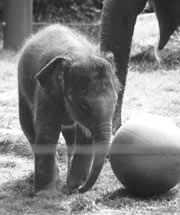Cat fights, dog fights, or elephantine showdowns—animal issues can be the best and worst of horses for politicians to ride. From off-leash dog runs to tribal whale hunts, they incite ferocious passions in some citizens and searing scorn in others, who wonder why our solons waste their time and ours on them. And so the battle begins over whether to let the circus keep coming to town. Mayor Paul Schell stepped into this one even before he became mayor, when animal-welfare activists approached him about banning exotic animal performances and displays, and he said he was game. Last October—a few weeks before the WTO arrived and Schell’s reputation took a beating— he came through and announced he would propose such a ban after the election.
That same month, the city of Redmond actually adopted such a ban. For Redmond, as for a few like-minded towns in Massachusetts, Florida, Maryland, and California, it was a preventive and symbolic measure: The most exciting performing-animal action in Redmond is ordinarily the pony rides at Sarrel-McWhirter Park.
But that victory emboldened the activists, who’ve set their sights on Seattle—a city that actually hosts three-ring circuses, the most conspicuous and controversial showcases of performing animals. Adding Seattle to the circus-free list might encourage other cities; the activists say Cincinnati and Alexandria are considering bans. Then again, given what Joan Galvin, vice president of governmental affairs for Feld Entertainment, the parent company of Ringling Bros. and Barnum & Bailey Circus, calls Seattle’s “liberal, progressive reputation,” it might not have much effect in the heartland.
Even here in the Progressive Republic of Seattle, going after the circus could prove politically dicey. When Schell announced his intent last fall, skeptics asked why he fretted over elephants rather than the city’s real business. Seattle Times columnist Nicole Brodeur nattered at him for playing “Dr. Dolittle” verging on “do little.”
Since then Schell has stayed out of the circus limelight. But last month his office quietly delivered up draft legislation to ban performing animals from city-owned facilities—and left it to the City Council to carry it through. Two of the council’s newest and youngest members, Heidi Wills and Judy Nicastro, have taken the lead in sponsoring the bill, which comes up for a Parks Committee vote next week. Passage looks assured; the committee’s chair, Nick Licata, has signed on as a cosponsor and says the bill already has the five votes it needs. But the ban on show animals may not prove such an easy ride, even in PC Seattle and even though it’s more restrained than the outright bans adopted by smaller cities: It would merely forbid displaying “exotic” (i.e., wild and potentially dangerous) animals in city facilities. But Feld’s Galvin says this would be enough to drive out Ringling, since the city-owned KeyArena where it performs each autumn is Seattle’s only suitable venue. And, she warns, Feld might also withhold its Disney on Ice and other shows: “If we’re not welcome, then. . . .”
“The Greatest Show on Earth” won’t go gently from Seattle, or out of the performing-animal business. Feld has hired one of the top local political guns, Northwest Strategies, to work its case, and Galvin herself has been out lobbying council members. As the debate heats up, you’ll doubtless hear many vehement declarations from both sides on the true nature of performing animals, especially elephants, the critters at the center of both the three-ring show and the animal-welfare debate. The activists will recite the problematic aspects of making elephants perform: the perennial deaths of wayward elephants, their handlers, and the occasional spectator; the grueling travel and confinement that elephants, tigers, and other wild animals must endure on the road; the “degrading” and “unnatural” actions they must perform in the ring; the physical coercion required (using chains, ropes, and the ankus bullhook) to dominate four-ton beasts. They’ll show the pachyderm equivalent of the Rodney King video, with keepers at unidentified circuses slapping, poking, and yanking their animals.
Ringling Bros., which animal behaviorist/activist Ellen Leach concedes is “probably the best” in a bad business, will try to distinguish itself from other, shabbier operators. Its people will insist they’re emphasizing reward-based “operant conditioning” rather than physical discipline, just as zoos are. They’ll explain that the animals aren’t performing or tightly confined all the time: The elephants stretch and play inside portable electric perimeter fences, and the big cats get daily breaks in an exercise cage Galvin says is as big as a circus ring. And they’ll contend that the animals are merely being directed to repeat “behaviors they perform on their own”—as when elephants stand on their heads to dig for water or crush melons.
At some point the debate will turn to a sticky question: Where do you draw the line? Wills, Nicastro, and doubtless many other supporters of a performing-animals ban see Seattle’s Woodland Park Zoo as an entirely different animal: a noble institution dedicated to educating the public, preserving endangered creatures, and showing them in naturalistic habitats. But Woodland Park’s elephants paint pictures (which are sold to raise funds) and stack logs in an exhibit modeled after a Thai logging camp. Its keepers carry ankuses and use chains when they need them. And they still practice a softened form of “free contact”—interacting directly with the elephants, without physical barriers. By contrast, Tacoma’s Point Defiance Zoo manages its three famously eccentric and dangerous elephants with hands-off “protected contact,” using neither strokes nor blows. Its elephant manager, Sally Joseph, says starkly, “There really isn’t any difference in training technique between what they do at Ringling Brothers and what they do at Woodland Park.”
The fight may be as much a class of cultures as of animal-behavior philosophies—especially if Feld manages, as it threatens, to overturn any council action by getting a referendum on the fall ballot. (Council member Peter Steinbrueck already wants to “let the the people decide this moral issue.”) On the one hand are people, often young and often childless, for whom the three-ring circus is a corny, vulgar, outdated spectacle. Wills expresses this view ardently: “We live in a more enlightened age. Seattle is a sophisticated city, with more discerning tastes about what we consider important.” She, like Nicastro, deplores undignified, unnatural spectacle like “elephants in tutus, bears on bicycles, and tigers jumping through burning hoops.” On the other side are those who’ve lately taken their kids to a circus, or who remember the circus warmly from its pre-television heyday, when it seemed an essential American institution. Feld says 200,000 people have attended its Seattle performances since 1996 (not discounting repeats). It also points to a poll of 500 Seattle voters it commissioned from Evans/McDonough in October. Three-quarters agree that “The circus is a wholesome and safe place to take children” and “Animals are an essential part of the circus.” That last view is gospel at the company, from owner/producer Kenneth Feld on down. “Again and again,” he says, “our research shows that’s what people come to see.” Plus, he says, he loves the elephants himself, and seems to mean it.
I happened to buttonhole Feld a month ago as he supervised the final dress rehearsal of Ringling’s new 2000 show in Tampa. The show sought to rise to Wills’ “sophisticated and enlightened” standard. A solo acrobat on elastic rings did a slow, soaring aerial ballet as poetic as Cirque du Soleil. There were no burning rings, bears on bicycles, or tutus on anyone. No longer does a swaggering “lion tamer” slip his charges surreptitious treats while pretending to control them with whips, chairs, and guns. Now the lissome young trainer conspicuously rewards and coaxes her tigers; her instructions, like those of the horse trainer, are miked for the audience to hear. The impression conveyed was not the old “savage beasts mastered by force of will,” but rather, “This is how my kitties and I put on a show together.”
The new, more enlightened Ringling likewise tries conspicuously to exalt, not “demean,” its elephants. In the pre-show “Circus Experience,” one young elephant steals the show—and a bellyful of bread—in a take-off on the classic “Clown Caf颠skit. Later, a platoon of clown suitors—from tycoon to Elvis—piles out of the “Clown Car” (a new Bug) and woos the clown bride. She spurns all—until one offers her the supreme gift, an elephant! An imperial flourish, and in strides the pachyderm parade, in gold caparisons rather than tutus, for the show’s grand finale. It was a defiant answer to the critics’ charges: Demean elephants? We worship them.
This pageant played better than the kinder and gentler tiger act; take away the sense of menace and you take away the thrill of the big cats. And there’s the bind for Ringling: As it presents itself as a sort of animal-welfare group itself, the circus sheds its traditional rude (and, often, cruel) vitality. Will presenting elephants as objects of veneration, making a show of cooperation between trainer and animals, and making baby elephants at its Florida breeding center assuage the ranks who just don’t think big animals should travel and perform? Don’t bet on it. From small towns to Congress (where a bill’s been introduced to ban interstate transport of show elephants), this fight will continue—whatever happens in Seattle.
External links:
Ringling Bros. and Barnum & Bailey home page
The Performing Animal Welfare Society’s digest of reports on Ringling Bros., elephant treatment, and elephant legislation
Other groups active on the performing-elephants issue: Progressive Animal Welfare Society, Alliance for Animals








